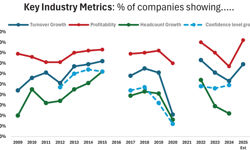Waterways World Ltd publishes the eponymous number one selling magazine for the canals and rivers of Britain. It also publishes Traditional Woodworking, SelfBuild & Design, Total Off Road and Vintage Spirit and provides circulation management and marketing for a number of other titles.
Our titles cover the full range of market characteristics – from a market leader in a mature static market, a second-tier title in a crowded and declining market, rapidly growing titles in rapidly growing markets and two recent launches. The approach to circulation management varies enormously as a result. I hope the insights into the promotion of specialist consumer titles from this experience will provoke some thought and analysis of your own titles.
My brief for this article is to look at newstrade promotions in terms of both cover-mounts/supplements and retail promotions with the multiples. I would, however, urge all publishers to produce a full circulation marketing strategy for each title that embraces subscriptions, newstrade and specialist shops. Most publishers agree that subscriptions are the future but then most pay lip service to subscriptions. For mature titles the main focus should be on subscriptions. A mature market is often in decline, static at best. You won’t increase your overall circulation, so squeeze the most out of it by reducing waste and locking away those readers. For new titles, newstrade should be the focus – without a secure newstrade sales base you will find it difficult to grow subscriptions (and note I say difficult not impossible!). Also make sure that "product" is part of your marketing strategy – if the product is not right then no matter where it is sold, at what price, with what promotional strategy your sales will not be maximised.
Cover-mounts and supplements
Why do we do them? Two reasons:
(a) added value to persuade the consumer to buy your magazine that month (preferably at the expense of a competitor).
(b) to increase supply to the newstrade by persuading them that you are promoting the title by adding value and, therefore, they are likely to sell more.
The obvious danger is that they simply add to costs without increasing sales. This is particularly so in a competitive market – if everyone promotes, everyone’s costs go up without necessarily any more magazines being sold. Sales won’t increase in this situation unless the market is growing anyway.
Do they work? Find out! Whatever you do, don’t produce them without measuring their effectiveness. That seems self-evident but good assessment of what does and what doesn’t work is the first rule of good marketing. Your budget is restricted, so work out what is effective and do more of it and less of the ineffective.
It may also seem obvious how you measure the effectiveness. Sometimes it is clear-cut. For one of our titles in 2002 average newstrade sales for promoted issues were 2,500 copies higher than for non-promoted issues. In other cases it is less clear-cut. The May 2002 issue of Waterways World sold 13% less copies than the April issue. Which one had a cover-mount? May. Does than mean it didn’t work? Not necessarily. May 2002 outsold May 2001 and May 2003. The April issue was a 5-week on-sale period and it covered the Easter weekend when boaters return to the water.
The 5-week month is wonderful concept. Most of us produce (calendar) monthly magazines but there are 52 weeks (and a day or two) in a year. Which means we get four (or sometimes five) months when the magazine is on-sale for an extra week (and designers and production controllers take their holidays). How much does it effect sales? Well I reckon it adds about 10% to sales. Look at this table which assesses sales through WH Smith high street stores for one of my titles using WHS weekly EPOS data (the on-sale periods don’t tie up exactly to full weeks, but daily data confirms the story).
| Share by week | ||||||
| Average Sales | 1st Week | 2nd Week | 3rd Week | 4th Week | 5th Week | |
| 4-week issues | 3,846 | 39% | 28% | 19% | 14% | - |
| 5-week issues | 4,375 | 33% | 26% | 17% | 13% | 11% |
This is over a 4-year period and shows that the 5-week issues on average sold 14% more than the 4-week issues, and the 11% share for the 5th week confirms that is what is happening.
Seasonality
Seasonality is another important factor to think about when planning promotions. Do your titles show a seasonal pattern? Again you need to work it out because seasonality can be hidden by long-term trends. Calculate an average sale for the year and then calculate each month’s sale as a percentage of that average. For example, if the average sale over the twelve months was 20,000 and sales in January were 18,000 then January would be 90. Finally average the January figure over, say, three years to get a three year average. Here is a chart on this basis for the Home Interest DIY sector (three titles – Homebuilding & Renovating, Build It and SelfBuild & Design) using wholesale index data over the 2000-02 period:
Sales in the Summer months are typically only 90% of the annual average with seasonal peaks at 10-12% above the average.
Work with the market rather than against. Promote in 5-week months to give your promotion the best chance of working. You will sell more copies anyway so supply needs to be relatively high to reduce sell-outs and maximise availability (which can be done without covermounts). And promote when sales are seasonally strong. Do not be tempted to try to "smooth the market" by promoting out of season, you will increase costs whilst minimising the impact on sales. When the market is receptive help it, don’t try to buck it!
Of course, even if a promoted issue works well you don’t know what would have happened if you hadn’t promoted. Would it have sold well anyway or if it didn’t appear to do well, whether it would have been even worse without the promotion. One way of testing the effectiveness is to trial a promotion with one retail group (an exclusive) or in a region by putting the supplement/cover-mount only on magazines supplied through selected wholesale houses. Also look at averages – compare the average of all promoted issues with the average of all unpromoted issues.
Retail promotions
Most publishers moan about the cost of retail promotions. Why should I pay £2,000 just for the privilege of being stocked by a particular multiple? Well, why should they stock your title? No one has a right for a shop to sell their goods – imagine the chaos if such a law was introduced for all goods! If the retailer is allowed to choose, and they are faced with perhaps 2,000 possible titles, on what basis do they ration their space? Best-sellers is one criteria but, with no alternative way of breaking into that space, this would be self-perpetuating. The real issues are around the level of cash payments and compliance – if the levels are appropriate, and if you’ve paid for an allocation it is not unreasonable to expect 100% compliance.
Having said all of that, how do you choose the retail promotions to seek? The first criteria should be to match the outlet to the title – motoring titles to garages and do not use supermarkets for male-oriented specialist titles, for example. Consider the regional bias of titles as well – some multiples are strong in certain regions so look at relevant retail multiples.
Don’t just judge them on the effectiveness of the promoted issue(s). Look at the costs and revenue after that as well. Here’s an example from one of our titles for which we paid £1500 for a 3-month allocation in a retail multiple group.
| Supply | Nets | |
| Average in 6-months prior to promotion | 603 | 399 |
| Average during 3-month promotion | 1,747 | 672 |
| Average in 12-months after promotion | 942 | 512 |
| Promotion cost | £1,500 | |
| Extra supply cost in promotion period | £1,236 | |
| TOTAL COSTS | £2,736 | |
| Extra revenue in promo period | £1,293 | |
| Loss | -£1,443 | |
| Extra cost in next 12 months | £1,466 | |
| Extra revenue in next 12 months | £2,142 | |
| TOTAL GAIN/LOSS | -£767 |
Our average supply prior to the promotion was 603 copies which rose to 1,747 during the promotion. Net sales rose from 399 to 672. The extra print costs for those additional 1,144 copies were £1,236, making the true cost of the promotion £2,736. The revenue from the extra sales was £1,300 giving a loss of £1,400. But look at what happened for the year after the promotion – supply was permanently higher and net sales were permanently higher. During that period the extra revenue outweighed the extra cost by £676 reducing the overall loss to £767. That assumes that we printed extra copies and didn’t just move them from within the existing supply – if there was no increase in overall supply then the total increase in revenue was £3,435 giving a net profit of £2,000.
Now if you really want to be clever you might say how many of those extra sales were simply diverted from elsewhere!? Well, in the 6-month period after the promotion, total average sales were 98 copies higher than sales in the 6-months prior to the promotion, when the sales through this multiple were 135 copies higher.
Although the cynic in me would say that this shows you can prove almost anything you want, I would strongly argue that you should always run this sort of analysis. You must measure the effectiveness of your promotional expenditure. It is true that the analysis will tend to confirm the 80-20 rule or the old adage that 50% of my marketing spend is a waste of time – if I only knew which 50% I wouldn’t spend it. With newstrade promotions, I think in many cases you would be hard put to justify the expenditure on a strict cost-benefit analysis. But the two very powerful arguments against that are: first, if you do nothing your circulation will drift down, it is the cumulative impact of promotions that works, not necessarily individual ones; and, second, "buying" circulation by aggressive newstrade promotions will improve your ability to sell advertising – which may alone justify it.










